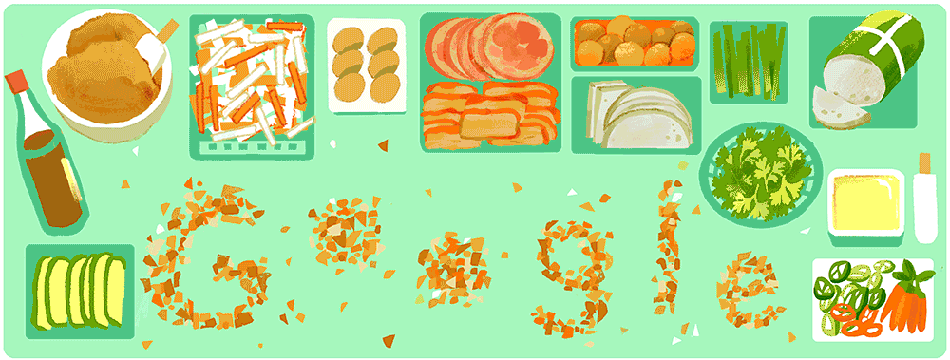
WE CALL IT A SUBMARINE SANDWICH
Bánh mì - Wikipedia
en.wikipedia.org › wiki › Bánh_mì
History · Ingredients of sandwich · Varieties · Notable vendors
Bánh mì or banh mi is the Vietnamese word for bread. In Vietnamese cuisine, it also refers to a type of baguette which is often split lengthwise and filled with various savory ingredients as a sandwich and served as a meal. Plain banh mi is also eaten as a staple food. Wikipedia
Main ingredients: Vietnamese baguette (also bánh mì)
Place of origin: Vietnam
Alternative names: Vietnamese sandwich
Invented: 1950s
Celebrating Banh Mi
Today’s Doodle celebrates the savory and satisfying Vietnamese street-food sandwich known as bánh mì, a smorgasbord of flavors that represents a true melting pot of cultures and ingredients alike. On this day in 2011, bánh mì was admitted into the Oxford English Dictionary.
Some accounts posit bánh mì’s humble beginnings in the late 1950s street stalls of Saigon’s noisy alleys, but an official origin story is yet to be verified. What is universally accepted about bánh mi’s history: its French inspiration, the staple baguette sandwich.
A traditional bánh mì consists of crispy and airy bread packed with a meat of choice (such as pork pâté, giò lụa, Vietnamese cold cuts, or meatballs), sweet, crunchy veggies and herbs (pickled radishes, carrots, and cilantro), a spread of mayonnaise or margarine, and savory soy sauce, finally topped with chili sauce or peppers. Voilà! By replacing European flavors with Vietnamese ingredients, a tangy and sweet while simultaneously spicy and salty takeaway food was born.
In current times, one can find countless spin-offs of the sandwich in street stands, markets, and restaurants across the world, from New York, to Seoul, to Saigon. Koreans often enjoy bánh mì’s stuffed with their signature bulgogi (barbeque beef) and kimchi. In the U.S., many popular recipes have traded the baguette with a brioche bun to create a miniaturized version: bánh mì sliders.
No matter the variation, you can relish the taste of cultures coming together!
The Origin of Hoagies, Grinders, Subs, Heroes, and Spuckies
Sub, hoagie, hero, grinder, spuckie, po' boy, wedge: here's why you call the footlong (or longer) sandwich whatever you do
BY SAM DEAN
ILLUSTRATION BY ERIK S. PETERSON
FEBRUARY 1, 2013

But for Super Bowl weekend, we don't just care about plain old sandwiches. We want foot-long (or six-foot-long) meat- and cheese-stuffed flavor bombs, those super-sandwiches we call "subs." Or "hoagies," or "grinders," or "po' boys," or "spuckies," or, if you're from Yonkers, "wedges." It's just one genre of sandwich, really, so why all the names, and where did they come from?
Well, back before big brands and big chains steamrolled "local color" into variations on beige, there was room for every American city to come up with its own name for a full-loaf sandwich filled with cold cuts, and most areas with large Italian immigrant populations did just that. While some of the names' origins are pretty basic, myths have swarmed to these sandwiches like flies on honey--so here, in no particular order, are the facts and fictions of our favorite sandwich's names:
Sub: An abbreviation of "submarine sandwich," subs are called "subs" because they look like submarines. Simple as that.
But the best myth puts the ground zero of subbery in New London, CT, around World War II. The city (well, technically the town of Groton, across the river from the city proper) is home to the Navy's primary submarine base and a large shipbuilding yard, both of which were understandably bustling during the war. According to this story, the big sandwich itself was invented by an Italian shopkeeper named Benedetto Capaldo in New London, but was originally known as a "grinder." Once the sub yard started ordering 500 sandwiches a day from Capaldo to feed its workers, the sandwich became irrevocably associated with submersible boats.
A nice story, but the OED's first printed record of "submarine sandwich" dates to a January 1940 phone book for Wilmington, DE, where a restaurant was advertising "submarine sandwiches to take out." Seeing as how we didn't mobilize for WWII until two years later, that pretty much torpedoes the New London legend.
Grinder: You're most likely to find one of these in New England, though the more common "sub" has taken over most of the terrain. "Grinder" shares some flimsy nautical roots with the sub--some claim that it was named for "grinders," Italian-American slang for dockworkers (who were often sanding and grinding rusty hulls to repaint them)--but the more widely attested origin is about the sandiwch itself. Subs, with their Italian bread and piles of fixings, were harder to chew through than your typical ham and cheese on white bread. That toothsomeness got translated into "grinder," since that's what your teeth had to do to get through a bite.
A note for nitpickers: at certain points in New England grinder history, grinders have been hot, while subs stayed cold, but that's come and gone over the decades.
Hero: Native to New York, the hero has two main origin stories. First, there's the logical speculation that it's a warped pronunciation of "gyro," the Greek sandwich with spit-roasted meat. But the term is attested back to the late '40s, and Greek gyros only made a splash in American food culture in the '60s, and even that began in Chicago. And maybe more importantly, all of these sandwiches are essentially Italian creations. The odds that a New Yorker in the '40s would mistake a Greek establishment for an Italian one are approximately nil. The real hero's journey began with the wonderfully named Clementine Paddleworth, who probably coined the word in a food column for the New York Herald Tribune in 1936, since the sandwich was so large "you had to be a hero to eat it." Since the NYHT went belly-up in 1966, there aren't any searchable archives online, but an enterprising food historian out there could go check out Rutgers University's microfilm archive to pin this one down for good. Barry Popik, on OED contributor and general food word expert, traces the word back to a 1937 Lexicon of Trade Jargon published by the WPA, which describes "hero" as "armored car guards jargon" for a big sandwich. That throws a little doubt on the Paddleworth Hypothesis, since it's unlikely a bunch of armored car guards would just pick up words from the paper willy-nilly, but the underlying "gotta be a hero to eat it" is still a strong contender.
Hoagie: This is the home-grown Philadelphia term for the big Italian sandwich, and has picked up not one but four explanations for its origin. The first two, strangely mirroring the "sub" story, start at the Philadelphia Navy Yard. The Yard was located on a chunk of land once known as Hog Island, so the workers there were accordingly called "hoggies." This was an early spelling of the local sandwich, and the story goes that the many Italian immigrant Navy Yard workers ate enough of them to get the thing named after themselves. Alternately, "hoagie" is said to come from "Hogan," in two different ways. First, it was a common Irish name, and became a nickname for the Irish immigrant Navy Yard workers, so like with "hoggie," they supposedly named it after themselves. Or, another story goes, a mug named Hogan asked a coworker who was always chowing down on delicious Italian sandwiches if he could start getting the lucky guy's wife to make an extra for him every day, and the name somehow stuck.
But considering that the Hog Island Navy Yard shut down in the '20s, and "hoagies" didn't start making the rounds in print until the '40s, that's fairly unlikely. I'll admit, it's weird that hoagies, subs, and grinders would all have apocryphal stories related to dockworkers, but the dates really don't line up on this one.
Instead, the real origin is more likely to go back to a jazz musician turned sandwich shop owner named Al De Palma. In the late '20s, he saw some fellow hepcats eating a sub, and commented to himself that you "had to be a hog" to eat a sandwich that big. So when he opened a sub shop during the Depression, he started calling his big sandwiches "hoggies," and eventually opened chains across the city. As for why "hoggie" turned to "hoagie," the best explanation out there is probably the Philadelphia accent itself. Ever heard those guys talk?
Po' Boys: The only strong contender for the true name of the sandwich outside of the Eastern Seaboard comes from New Orleans, where the sandwich goes by "po' boy," "po-boy," or the original, "poor boy." The best story about this name happens to be true, and it starts with a streetcar strike. In the summer of 1929, 1,100 New Orleans streetcar conductors and motormen went on strike, largely with the support of the city--when strikebreakers were sent in to bust picket lines and scab on the trolleys, a crowd of 10,000 New Orleanians gathered downtown to cheer on strikers as they burned the first scab-operated streetcar.
Two brothers named Bennie and Clovis Martin, Cajun Louisianians who used to work on the streetcars, sent a letter of support to the union pledging free meals to union members and their support "till hell freezes over." They followed through on their promise, giving out large sandwiches to any strikers that came by their shop, commenting to each other "here comes another poor boy" whenever one walked through the door. To maximize the food load, they worked with an Italian baker, John Gendusa, to come up with a rectangular sandwich loaf more efficient than the tapering baguette. As with the hoagie, the name then spread through the city as the Martins expanded their restaurant and stuck.
Etc.: Regional sandwich name microclimates abound, though the dominance of Subway is slowly grinding away at local specialties. In Southie (in Boston), you can order a "
spuckie" at the spa, short for spucadella, the name of an Italian roll. In Wisconsin, they go by "
garibaldis," named after a menu item at a local Italian restaurant (presumably named in honor of the hero of Italian unification). And there are plenty of shape names, like "
blimpie" (named after the Hoboken-based chain), "
torpedo," "
zeppelin" (found in Pennsylvania), and "
bomber" (near buffalo). And in parts of the upper Midwest, people call big sandwiches "
Dagwoods," after the famously hungry comic book character.
But the weirdest-sounding of all has to be "
wedge," which is only familiar to natives of Westchester County, NY, and Fairfield County, CT, the two counties directly north of New York City. Some sources group it in with the shape-names, based on a diagonal cut in the middle of the sandwich, or a wedge cut out of the top half to make more room for fillings, but the real story's probably the simplest on this list: "wedge" is just short for "sandwich," and comes from a Yonkers deli whose Italian owner got tired of saying the whole word.
In the end, it doesn't really matter what you call them, as long as you end up with a big sandwich in front of you (like one of these from our Ultimate Super Bowl Party Menu)--it's hard to say much of anything when you've got serious munching to do.
RELATED:
Some Americans Call Sandwiches Dagwoods
Having a Sandwich with the Earl of Sandwich
No comments:
Post a Comment